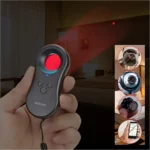IP cameras are the latest evolution in surveillance camera technology. But what exactly are IP cameras, and what benefits do they offer compared to old-school analog CCTV models? This beginner’s guide will explain the key things you need to know to get started with IP cameras.
What Are IP Cameras?
IP stands for “Internet Protocol” – the same technology that powers email, the web, and streaming services. An IP camera is one that encodes its video feed digitally and transmits it over an IP network. This is usually your home or office WiFi network.
Analog CCTV cameras use a different process – they transmit low quality video directly to a recording device via coaxial cable. IP camera video gets compressed into network-friendly digital packets perfectly suited for transmission over WiFi or ethernet cabling.
The IP digital encoding process allows for major advantages like:
- Significantly higher video resolution – up to 4K
- Convenient wireless connectivity
- Remote viewing from anywhere
- Integration with other IP smart home devices
- Analytics like motion sensing and smart alerts
- Scalable systems that are easy to expand
For both home and business surveillance applications, IP cameras provide huge improvements in video quality, smart features, and flexibility compared to outdated analog CCTV technology.
How Do IP Cameras Get Connected?
One of the benefits of IP cameras is that they can often utilize your existing home or office network cabling and WiFi. Here’s how to connect them:
Ethernet – Most IP cameras have a standard RJ45 ethernet port that allows using Cat5e or Cat6 network cabling. This wires the camera back to your network switch, router, or NVR recorder.
WiFi – Many IP cameras also have built-in WiFi connectivity. You connect them wirelessly to your home or office WiFi network, just like a smartphone or laptop.
IP Address – Each IP camera requires its own IP address on the network, which can be automatically assigned by your router’s DHCP server. This enables identifying and accessing the camera feed remotely.
PoE – For wired cameras, using PoE (Power over Ethernet) switches and injectors allow powering the camera through the same ethernet cable used for data transmission. This avoids the need for separate power cables.
The existing ethernet cabling and WiFi you likely already have is perfect for connecting IP cameras. And PoE makes installation even easier by powering and networking cameras using a single cable run.
Key Features of IP Security Cameras
Beyond just higher resolution video, today’s IP cameras are packed with cutting-edge capabilities. Here are some key features to look for:
- 4K resolution – 4X higher than 1080p HD, 4K IP cameras reveal incredible detail like faces and license plates.
- Wireless connectivity – WiFi-enabled cameras provide flexibility for placement anywhere within range of your network.
- Night vision – Infrared (IR) illumination enables seeing up to 100 feet or more at night, even in zero ambient light.
- Motion detection – Smart camera analytics detect people and vehicles, triggering alerts and recording only when needed.
- Mobile viewing – Apps for your smartphone or tablet allow checking footage and controlling cameras remotely.
- Local and cloud storage – Store video onsite on NVRs or leverage the cloud for offsite backup and management.
- Smart integrations – View camera feeds on smart displays, integrate with voice assistants, and automate actions.
Advanced analytics, mobile access, crystal clear 4K resolution, wireless installation and smart home integrations make today’s IP cameras incredibly versatile.
Ideal Placement Locations for Security Cameras
A key aspect of any security camera system is ideal camera placement. Here are some tips on where to install IP cameras:
Outdoor Locations
- Front door – Catch visitors arriving/leaving
- Driveways and backyards – See any suspicious activity
- Garage doors – Monitor for break-ins
Indoor Locations
- Entryways and hallways – Watch internal movements
- Living spaces – Keep an eye on valuables
- Home office – Monitor kids or employees
When siting cameras, consider these factors:
- Camera viewing angle to optimize visibility
- Nearby power outlets or PoE availability
- WiFi signal strength for wireless cameras
- Shelter from direct sun or rain
Proper placement is crucial for capturing important activities and ensuring the best video quality day and night.
Storage and Viewing: Local vs Cloud Options
A key decision for IP camera systems is how video gets recorded and stored. There are two primary options:
Local NVR Storage
An NVR (network video recorder) provides onsite recording and storage. Models with multiple terabytes support retaining high-resolution footage from multiple cameras for weeks or longer. But lack redundancy if damaged or stolen.
Cloud Storage
Cloud plans securely store video offsite on remote servers. This protects recordings even if hardware gets damaged. But incurs monthly per-camera fees. Hybrid approaches leverage both local and cloud storage.
Viewing is done through mobile apps or web browser. Many IP cameras also integrate with smart displays like Amazon Echo Show or Google Nest Hub for quick video checks.
IP Camera System Cost Considerations
IP camera system costs depend on:
- Number of cameras – More cameras means higher hardware costs. Plan for current and future needs.
- Camera types – Simple indoor WiFi cameras start under $100. Advanced 4K models run $300+. High-end PTZ cameras with remote pan/zoom cost even more.
- Local storage – NVR appliances for local recording range from $200 entry models up to enterprise-grade units over $1000.
- Cloud storage – Optional cloud recording plans cost ~$5-10 per month per camera depending on features and retention timeframe.
- Installation – DIY is cheapest but requires time and networking expertise. Professional installation costs $100 or more per camera.
IP camera systems provide scalability to add cameras over time in a modular fashion. Letting you initially invest only in what you need today.
Conclusion
This IP camera basics guide covered how IP cameras work, key features, ideal placement, storage options, costs and more. Upgrading from old analog CCTV to modern IP cameras enables enjoying huge benefits:
- Massively improved 4K video clarity
- Convenient wireless installation
- Seeing activity day or night
- Smart motion sensing alerts
- Easy access from mobile devices
- Integration with other smart home tech
IP camera systems meet both home and business security needs with unparalleled quality, automation and remote monitoring capabilities. And they leverage your existing network infrastructure for simple setup.
For most users, choosing a starter IP camera kit from a leading brand like Arlo, Lorex or Nest provides an easy path to enjoy major security monitoring improvements over outdated CCTV.
Top Brands of IP Cameras for Beginners
Here are some top-rated entry-level IP security camera models and kits to consider from leading brands:
Google Nest Cam Outdoor – $179
Lorex 2K Indoor/Outdoor Cameras – $99 each
Ring Spotlight Cam Battery – $199
TP-Link Tapo C200 Camera – $79
Wyze Cam v3 – $35
Starting with 2-3 cameras from reputable brands like these enables cost-effectively experiencing the key benefits of modern IP surveillance systems vs analog CCTV. You can always expand your coverage as needed.
So if you’re still relying on dated low resolution CCTV cameras, now is the perfect time to upgrade your home or business security monitoring to crystal clear IP camera surveillance. The difference is like night and day.



